Wixárika Research Center Newsletter Spring 2012
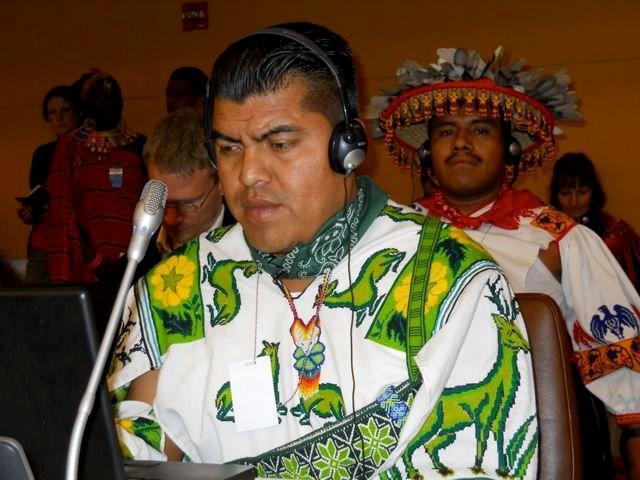
Santos de la Cruz and Filipe Serio at the UN Forum on Indigenous Peoples
Wirikuta Update
Since our last newsletter in April of 2011, the Wixárika Council for the Defense of Wirikuta and the Front in Defense of Wirikuta[1] have continued actively opposing mining and agro-industry in Wirikuta. At the time of our last newsletter, our efforts were mainly focused on the concessions granted to Canada’s First Majestic Silver Corporation, in the area of Real de Catorce. As we wrote last year, this project which has since been renamed Project La Luz, consists of 22 mining concessions covering an area of 6,326.58 hectares of which 70% are located within the Wirikuta protected reserve. Since that time, one of the biggest threats to come to light is that of another Canadian corporation, Revolution Resources, which has purchased concessions in the heart of Wirikuta. This project, named El Proyecto Universo, has plans to exploit 59,678 hectares inside the protected area of the Wirikuta reserve. This project is much larger and the plans are for an open pit gold mine which is the most damaging form of mining for the environment. To learn more about mining and Wirikuta please read the article by Florencia Podesta “What is Wirikuta” (link at the bottom of this Newsletter).
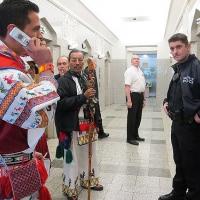
During these past eleven months the Wixárika Council for the Defense of Wirikuta and the Wirikuta Defense Front, of which our foundation is a member, have carried out a number of events and actions in protest of these concessions. In May of last year a delegation of three Wixaritari traveled to Vancouver Canada to attend First Majestic Silver’s stockholder’s meeting. Two of these delegates had proxies allowing them to attend the meeting. Still, security tried to bar them from entry and it was only after much assistance that they were allowed in. We were fortunate that Cilau Valadez was one of those who held a proxy since he is fluent in English. The other delegate was Jesús Lara Chivara. Neither was allowed to address the stockholders present, but they were permitted to hand over a document to the CEO Keith Neumeyer. Coinciding with the stockholder’s meeting of First Majestic Silver was a week of actions held by Mining Watch Canada and attended by Native Americans from other tribes.
Simultaneously, a second delegation of two Wixaritari, Santos de la Cruz and Felipe Serio, traveled to New York for the United Nations 10th Permanent Forum on Indigenous Rights. Our colleagues at Cultural Survival facilitated their participation in the forum. Santos read the Wixárika Declaration on Wirikuta into the record, while Felipe distributed information to many of the people in attendance. Before leaving New York, they attended a private
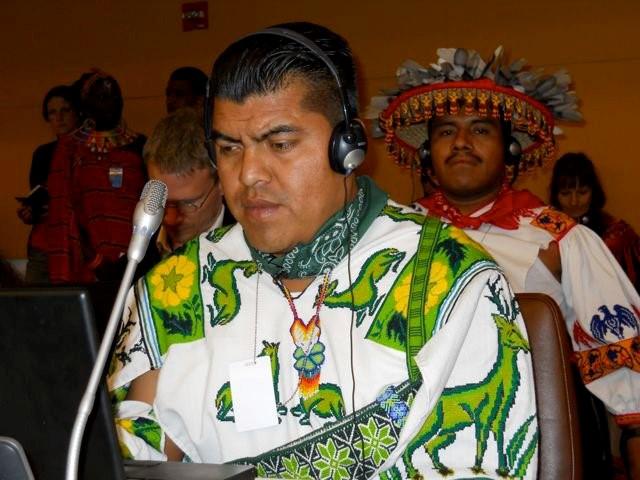
Santos de la Cruz and Felipe Serio at the United Nations
meeting with Mr. James Anaya, the Special Rapporteur for the Rights of Indigenous Peoples, who promised to give special attention to the issue of mining in the sacred area of Wirikuta. Since their meeting in New York, Mr. Anaya has been in correspondence with the Mexican government and the issue of mining in Wirikuta was included in his yearly report.
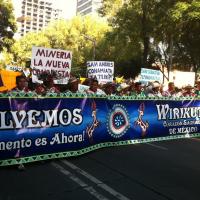
On September 8th the first music festival for Wirikuta, Festival Tatewarí, was held in an effort to gather funds to cover some of the expenses for travel, lodging and meals of the Wixárika people and their representatives so they could attend the various meetings and events being held in Mexico City. From September 7th through September 9th, Wixárika representatives attended the forum on “Mines in Natural Sanctuaries of Latin America” at the UNAM. A second concert, Watákame, was held on the 14th of October at the Centro Cultural la Pirámide. On October 15th, Wixárika representatives attended the event held by the Movement for Peace and Justice at the Chapultepec Castle which was attended by President Calderón and his wife. At this meeting, Santos de la Cruz was allotted a few moments to personally address the President and hand him a folder of documents on Wirikuta.
On October 26th, members of the Frente held a press conference and panel discussion in Mexico City which was attended by the legal representatives from all Wixárika communities. Five buses were rented to help transport more than 200 Wixaritari from the sierras for the event. Numerous speakers participated and the event was well covered by the national and international press and national TV. The following day, October 27th, a march took place down a major avenue in Mexico City to Los Pinos, the residence of President Felipe Calderón, where the Wixárika delivered yet another letter to the President of Mexico calling for the cancellation of all mining concessions and large agro businesses in Wirikuta. The document was signed by all the communities and their annexes. More than two thousand people joined in and marched in solidarity with the Wixárika people. Other events were organized including meetings at the UNAM (National Autonomous University of Mexico) and many new alliances were formed. A link to the video of this march can be found at the bottom of this newsletter.
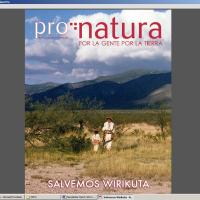
Meanwhile, we were busy corresponding with other NGO’s to see if we could interest them in helping with our campaign to get the mining concessions in Wirikuta canceled. The response from the IUCN (the International Union for the Conservation of Nature) was particularly positive and they contacted Pronatura[2] in Mexico City to see if they would be able to help. Pronatura suggested they could publish an article on the mining threat to Wirikuta in their November and December supplement in Newsweek en Español. As a result, Juan and Diana Negrín coauthored an article, illustrated with 12 color photographs taken by Juan on his pilgrimages to Wirikuta. Mercedes Otegui of Pronatura wrote an excellent editorial on the matter. The article was given the cover of the supplement with the heading “Salvemos Wirikuta” (“Save Wirikuta”). Since Newsweek en Español is distributed in 12 countries in Latin America and the United States, the news of the mining threat and tomato farming to Wirikuta received broad international attention.
By the end of 2011, the Wixárika Council for the Defense of Wirikuta began planning for a major event where all the ceremonial centers from the communities would coordinate their pilgrimages to Wirikuta so they could gather on a set day at Re’unaxü (Burnt Peak) for a night long vigil to pray and ask their ancestors for guidance. Again it was necessary to rent buses to transport the pilgrims from their different communities and ceremonial centers this time through the desert. Donations were gathered during the month of January and the pilgrimage took place as planned during the first week of February 2012, with some 800 Wixaritari making the journey. On the night of February 7th, the pilgrims climbed to the top of the mountain under a full moon, above Real de Catorce, to their sacred spot, where according to their oral history Our Father Sun illuminated this world to hold their vigil. An exception was made for this special occasion and the visitors, television crews, and reporters, who had traveled to Real de Catorce, were allowed to travel up the mountain to be present and witness this historic ceremony. Once again the issue of mineral exploitation
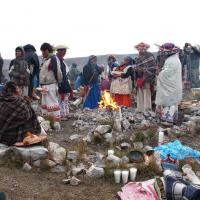
in the protected reserve and pilgrimage route of Wirikuta was in all the major national newspapers. On the morning after the vigil, the Declaration of Wirikuta was issued and the Wixárika communities made clear that they were unified in their battle to save Wirikuta from the ravages of the mining and agricultural industries. Tracy Barnett of the Esperanza Project was present and covered the event. Links to her three articles are posted at the end of this newsletter. The news of this pilgrimage appeared in the Washington Post and was reprinted by numerous newspapers throughout the United States and was covered in Europe and Latin America.
At the end of February, the Wixárika people learned that the Federal Judiciary had approved the injunction they had filed, ordering a temporary halt to any activities by First Majestic Silver until the dispute is settled. Although this injunction does not cover other mining concessions within Wirikuta, it sets an important precedent.
In mid March, two ceremonial centers from the community of San Andrés Cohamiata and others from the community of Guadalupe Ocotán, who had not participated in February’s pilgrimage, made their own pilgrimage to Wirikuta. This pilgrimage was timed to coincide with a meeting in the desert with Bruno Ferrari, the Secretary of Economy and with the Federal Director of the CDI[3]. The meeting was also attended by the agrarian and traditional authorities of San Andrés Cohamiata and Guadalupe Ocotán and by the Wixárika Union of Ceremonial Centers. Members of the communities of Santa Catarina and San Sebastián attended as witnesses. It should be noted that the CDI carried out a new geo referencing of Wirikuta in 2011, with the assistance of elders from the communities in order to identify Wirikuta’s boundaries and this resulted in the reserve being expanded by some 60,000 hectares to approximately 200,000 hectares. After this meeting in Wirikuta the CDI held a second meeting in Colotlán, Jalisco, where they presented documents to the communities to sign, requesting that UNESCO recognize Wirikuta as Cultural Intangible World Heritage. The communities of San Andrés Cohamiata and Guadalupe Ocotán signed and Santa Catarina Cuexcomatitlán and San Sebastián Tepostitlán abstained based on their opinion that Wirikuta is tangible and should be declared UNESCO Cultural and Natural World Heritage. We hope that Wirikuta will eventually be declared a Natural World Heritage as well, since this is the classification that will offer the best protection of the area. Since the issues and events related to Wirikuta and its defense are too complex for this newsletter, we will post an additional report soon and send out a notification to our subscribers.
Update on the activities of the Wixarika Research Center
This past year has been full of activity due to the ongoing campaign to save Wirikuta from the devastations of mining. It is an issue of such vital importance to the Wixárika people that it has often had to take priority over our other work. Notwithstanding, there are a number of changes and advancements we would like to mention.
First, in the fall of 2011, we welcomed a new board member. María Cruz. The new Secretary of the Board of Directors of the Wixarika Research Center brings with her a unique relationship to the Wixárika people. Her grandmother’s family was from the town of Huejuquilla el Alto and her great grandfather was Wixárika from the community of Tuapurie (Santa Catarina Cuexcomatitlán). María is a doctoral candidate at University of Texas, Austin, who is now living in the Bay Area and is presently in the process of completing her dissertation, which looks at how government agencies carry out policies and laws that play a role in forced migration, relocation and dislocation of the Wixaritari. Diana Negrín, having been replaced as Secretary by María, is the new President of the Board of Directors. We feel these changes will bring new vitality to the Wixarika Research Center since both María and Diana are deeply involved with issues of concern to the Wixárika communities.
An important accomplishment last fall was our participation in the election of Tutupika Carrillo to the post of Consulting Advisor for Sustainable Development of Indigenous Communities for the SEMARNAT of Nayarit.[4] The person who holds this position is responsible for representing the interests and vision of all the indigenous communities of the region. A friend who works with the SEMARNAT of Nayarit advised us that this important post had been vacated and that he hoped to nominate someone from a Wixárika community who was residing in Nayarit and asked us if we could recommend someone from a Wixárika community. After some internal discussions we suggested Tutupika Carrillo, who is from the community of San Andrés Cohamiata and who we know to be a very ethical individual. Tutupika received his degree from the Autonomous University of Nayarit where he now teaches and has been a staunch defender of his people, their territory, and their human rights. Aside from his teaching position at the university, he had been working closely during the past year with the director of Human Rights for the State of Nayarit. After our recommendation, Tutupika was nominated and elected and we are confident that he will be a strong ally for the indigenous communities of Nayarit.
During the past 11 months, we had two volunteers give time towards digitally archiving documents and images. Matthew Ogdie came twice a week from May through the end of July to scan documents. More recently, Hans Michael Jantzen has been donating time on a weekly basis, to scan 35mm slides in high resolution and simultaneously create a data base of the images for the purpose of long term preservation. The 35mm slides were taken by Juan Negrín from the early 1970’s to the present and represent an important historical archive. The images document pilgrimages, ceremonies and sacred spots with their idols and offerings. Since these photographs were taken, many of the sacred places were robbed of their stone idols by outsiders, making the record of these objects in situ important for their recuperation by the Wixárika if they were to appear on display somewhere. The work of scanning was begun by Yvonne Negrín, but with the ongoing Wirikuta campaign it became difficult for her to continue this work on a steady basis, so we are very appreciative of the time Hans Michael is dedicating to this important task. Now we have a third volunteer, Plinio Hernández, who will soon begin the work of transferring cassettes taped by Juan Negrín into digital format. This work is very necessary in order to preserve the recordings and to make them available to be worked with again. Many of the cassettes are more than 40 years old and magnetic tapes can eventually be lost with time. Plinio will work on the tapes of conversations and interviews. Other tapes, the ones of chants and music, we hope to have transferred in a professional studio to get the best results possible. This will require funding.
It is worth noting that last September our foundation’s main computer, which is used for doing all of the above mentioned archival work, finally failed after almost 10 years of service and we were fortunate not to lose any of our data. Because there was no money in our budget to cover the cost of a new computer that would have the power and all the necessary components to handle the work of archiving, we were fortunate that Wes Headley, who had built our old computer, had a workstation he had built for himself and which had very little use and was totally compatible with our needs. This saved us considerable money and enabled us to be up and running with little time lost.
One of the things we will seek funding for this year is the rebuilding of our website in Drupal. By doing so, the website will offer much more in the way of interactivity, which is something we feel it has lacked. The Drupal platform will enable our viewers to make comments on posts and articles, and will save us valuable time, since many tasks we now have to perform manually will be accomplished automatically.
It is worth noting that the Wixárika Research Center has two pages on Facebook. A group page can be found under the name “Huichol Cultural Survival” and the second page is listed under “Wixarika Research Center”. Links to these pages are provided below. We regularly post news items and videos in on both pages in English and Spanish. We encourage you to join us on Facebook, if you are a member, since it is an easy way of keeping up with our frequent posts on Wirikuta and other important news as it happens.
Last November, at the time we normally send out our newsletter with an appeal for donations, we were faced with a very short deadline to locate and scan the images and write an article on the issue of mining concessions in Wirikuta for the November – December issue of Newsweek in Español’s Pronatura Supplement. We made the article our priority, knowing it would call unprecedented international attention to the issue of mining and agro-industries in Wirikuta. As a result our last request for donations was sent out in early 2011. Now your support is urgently needed to close a gap in our budget between mid June and the end of August. Funds are needed to cover our most basic expenses during these months to enable us to keep doing our archival work, web site updates, and advocating for the Wixárika and the preservation of Wirikuta. We expect a scheduled donation to arrive at the beginning of September which will carry us through the end of the year but it is critical we cover our operating expenses through the end of August. Please consider making a donation now if you are able. Donations of any amount will be greatly appreciated and can be made securely on line by credit card or, if you prefer, by check and mailed to the Wixarika Research Center, 863 Leo Way, Oakland, CA 94611-1964. For those of you who are receiving our newsletter by mail and would like to make a donation by credit card, you can go to www.wixarika.org and on our home page in the upper right hand corner you will find a link that will take you to the page where you can make a secure donation. We are a 501 (c) 3 non-profit foundation and all donations are tax deductible to the full extent of the law.
We thank you for your support!
The Board of Directors
Wixarika Research Center
Join us on Facebook: Huichol Cultural Survival and Wixarika Research Center
Links for additional information:
What is Wirikuta by Florencia Podesta
Video of the March in Mexico City
Declaration of Wirikuta
Report on February’s pilgrimage by Tracy Barnett – Part I, Part II and Part III.
Endnotes:
[1] The Wirikuta Defense Front, Tamatsima Waha’a, is a coalition of Wixaritari, NGO’s and individuals dedicated to achieving the cancellation of all mining concessions in Wirikuta.
[2] Pronatura is the largest Mexican environmental conservation group. Founded in 1981, the organization covers 17 Mexican states, being now composed of 6 regional representations: Pronatura, A.C., Pronatura Chiapas, Pronatura Noreste, Pronatura Noroeste, Pronatura Península de Yucatán, and Pronatura Veracruz. These non government, nonprofit organizations share the mission of the conservation of the flora, fauna and priority ecosystems of Mexico, promoting society's development in harmony with nature.
[3] CDI stands for Commission for Indigenous Development and is the government institution that replaced the National Indigenous Institute, INI.
[4] SEMARNAT, i.e. Secretariat of the Environment and Natural Resources, is the Cabinet level department of the Executive branch responsible for developing environmental policy and legislation.





